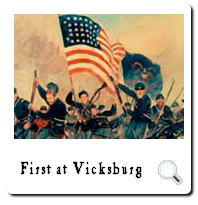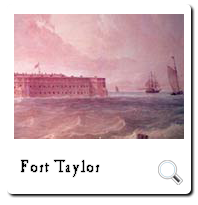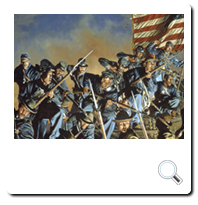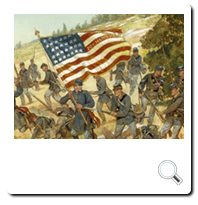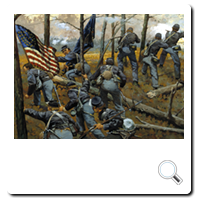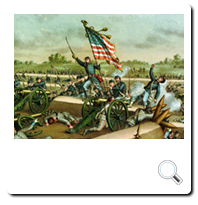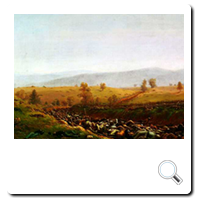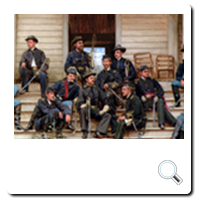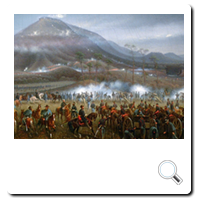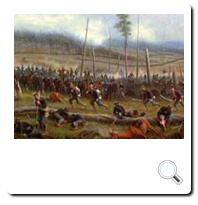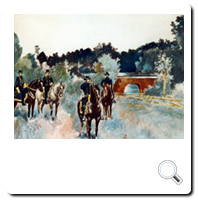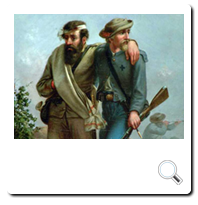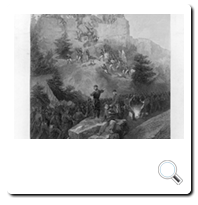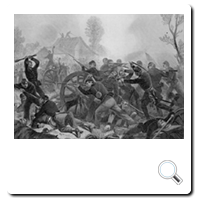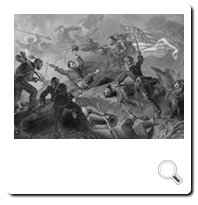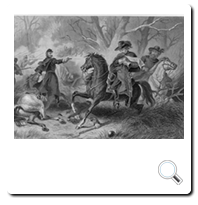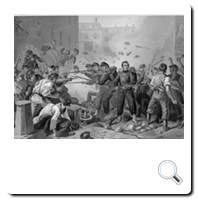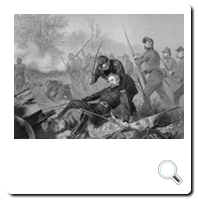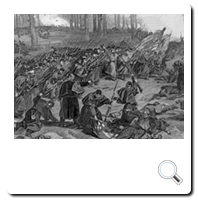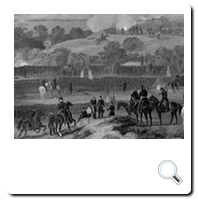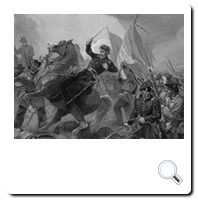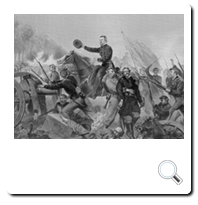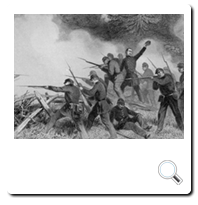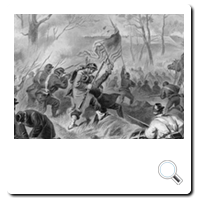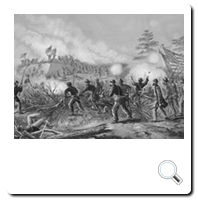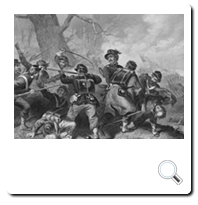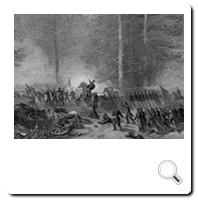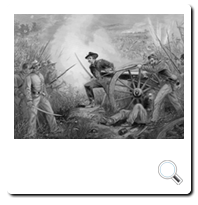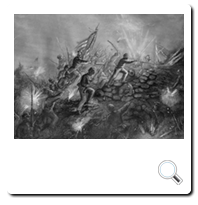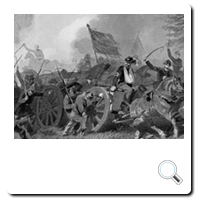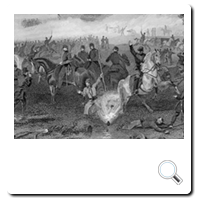
Selected Civil War Art
from CMH Prints and Posters Sets
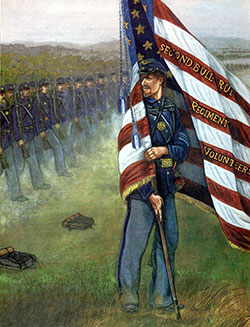
Dress on the Colors
Virginia, 1864
Hi-Res (613KB) (1655x2163)
Part of The Noncommissioned OfficerDuring the Civil War, sergeants and corporals preserved order when troops massed in line and assisted the officers by leading small units deployed for skirmishing. The color sergeant, performing what had once been an officer's duty, became the pivotal point in battle around which the regiments advanced and wheeled. Visible through the smoke and dust of battle, the sergeant's colors attracted the heaviest enemy fire and became the center of hand-to-hand combat.
+ Click here to expandHere a regiment advances during the siege of Petersburg by aligning itself on the color sergeant.
Each infantry regiment had two colors, the Stars and Stripes and a second with a solid field bearing the national arms. Both flags were large, 6 by 61/2 feet, mounted on 91/2 foot pikes. The national colors, shown here, bore the regimental designation on the central stripe. It became the battle flag, the one usually carried into combat. The practice of inscrib-ing honors on the other stripes during the Civil War led to the modern custom of streamers. Each flag was borne by a color sergeant, a special duty position distinct from the company-level NCO. He was protected by the six corporals of the color party.
Sergeants in the Civil War were distinguished by their chevrons and trouser stripes and by their right to carry a sword, in this instance, a model 1840 NCO sword suspended from a shoulder belt and waist belt with distinctive eagle plates. Branch insignia included devices (for infantry, the light infantry horn) as well as the distinctive color of the uniform trim. Each foot soldier carried his possessions in a painted canvas folding knapsack with blanket roll strapped above. The knapsack was the first thing dropped before going into action. The soldier, however, was rarely separated from his haversack, which contained his rations, and from his tin canteen.
- Click here to close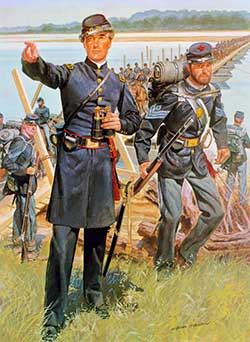
The American Soldier, 1863
Part of The American Soldier: Set 2These Union uniforms, worn here by soldiers in the western theater of operations at the midpoint of the Civil War, illustrate the continuing trend toward simplicity of style and subdued, if not drab colors, which first came into widespread use in the Army during the War of 1812.
These veterans are garbed in the regulation blue, which offered protective coloring and concealment, and less likelihood of the wearer's becoming an obvious target of the long-range small arms and more efficient artillery of the Confederate Army.
+ Click here to expandIn the left foreground is a first lieutenant of the Corps of Engineers in the dark blue frock coat and trousers, with a gold cord down the side adopted in 1861. He is identifiable by his shoulder straps, officer's red sash and sword, and the forage cap badge of an engineer officer-a silver turreted castle within a gold wreath. His rank is indicated by the single gold bar on his shoulder strap; a second lieutenant at this time wore an officer's uniform with gold bordered, but unadorned, shoulder straps.
The first sergeant of infantry in the right foreground is identified as such by his dark blue sack coat and his light blue chevrons, noncommissioned officer's sword and red sash. He is wearing the light blue trousers adopted after the outbreak of hostilities for regimental officers and men. The red acorn corps badge on the sergeant's fatigue cap shows that he is a member of the 1st Division, Fourteenth U.S. Army Corps.
In the background, soldiers of the sergeant's regiment and of an artillery unit are crossing a ponton-or pontoon in 19th century usage-bridge, which was probably erected under the lieutenant's direction.
This image of represents two of the three traditional combat arms and the engineers of the traditional direct combat support arm, also illustrates the beginnings in the concept of a co-ordinated combat team.
- Click here to close
The American Soldier, 1863
Part of The American Soldier: Set 3The use of riverboats, steamships, and railroads during the Civil War greatly increased the mobility of armies. However, armies in the field required still another type of transportation. Wagon trains not only had to accompany troops on active operations but also had to be employed to distribute stores brought in bulk to railway terminals and steamer wharves. The Army wagons and harness had been perfected by long years of experience and operation on the western plains.
+ Click here to expandThe wheels, axles, and other principal parts were made to standard measurements to permit interchangeability of parts. Early in the war the Army procured both horses and mules for use with trains, but experience later convinced quartermasters that mules were far superior to horses for such service.
In the foreground is a sergeant of cavalry in the dark blue cloth uniform jacket prescribed for all enlisted men of the cavalry and light artillery. His unit and arm are recognizable by the yellow metal insignia on his kept, the yellow lace trimmings on the collar and cuffs, and around the edge of the jacket. The first sergeant's yellow worsted binding chevrons and lozenge, the stripe on his trousers seam, and the red sash show his rank, while the half-chevron on his lower sleeve testifies to faithful service. His light blue overcoat is strapped in front of the pommel and he is using the dark blue saddle blanket with an orange stripe adopted in 1859.
In the left center is a major of ordnance in the dark blue, double-breasted cloth frock coat, with two rows of seven buttons worn by all field grade officers. The dark blue ground of his shoulder straps shows that he is a member of the General Staff or Staff Corps, and the gold oak leaves show his rank as major. The Ordnance Corps insignia on the front of his forage cap is a gold embroidered shell and flame on a black velvet background, and on the gilt, convex buttons on the frock coat are crossed cannon and a bombshell, with a circular scroll over and across the cannon, containing the words Ordnance Corps.
In the background is an Army train manned by civilian teamsters and composed of white covered wagons with "bluish tinted" bodies and wheels "of Venetian red darkened to a chocolate color."
- Click here to close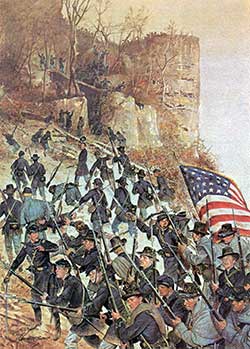
The American Soldier, 1862
Part of The American Soldier: Set 5With the outbreak of the Civil War in the United States, a number of ethnically-oriented militia groups responded to President Lincoln's call for volunteers to preserve the union. One such unit to volunteer was a predominantly German-American unit known as the Citizens Corps of Milwaukee. On 25 and 27 April 1861, the unit officers, William Lindwurm, Frederick Schumacher, and Werner Von Bachelle were commissioned captain, first lieutenant, and second lieutenant of the company, respectively.
+ Click here to expandBy 10 May 1861, the company was officially mustered into the evolving 6th Wisconsin Regiment as Company F, bringing the total of German-Americans in the Union Army to almost thirty-six thousand.
On 16 July 1861, the 6th Wisconsin Volunteers departed for Washington, D.C. Here, the regiment was brigaded with the Union Army's 2d and 7th Wisconsin Regiments and the 19th from Indiana, under Brig. Gen. John Gibbon. The brigade, in 1862, achieved increased efficiency and military prowess and a distinctive uniform that resulted in the nickname "Black Hat Brigade" from fellow Union soldiers. Following the brigade's determined assault upon the heights at Turner's Gap at South Mountain, Maryland, Gibbon's brigade won a new title, "The Iron Brigade of the West". Three days later, the unit proved its worth once again by bravely assaulting Lee's forces in one of the bloodiest battles of the war.
Shown in the painting is the brigade assaulting the Confederate forces at Turner's Gap. The men of the 6th Wisconsin Volunteers are wearing dark blue frock coats with sky-blue trousers. A few are attired in grey overcoats. All are wearing either the black wool/felt hat with a sky-blue double looped cord or Model 1858 forage cap. Armed with the M1861 Springfield muzzle-loading rifle muskets, the men of the Wisconsin units prepare to meet the enemy at the summit.
- Click here to close
Selected Civil War Artwork From the
National Guard Heritage Collection
Visit the National Guard Heritage Collection website
Selected Civil War Art From the
Army Art Collection
The following are selected artwork from the Army Art Collection. Please click here for additional information about the Army Art Program.

